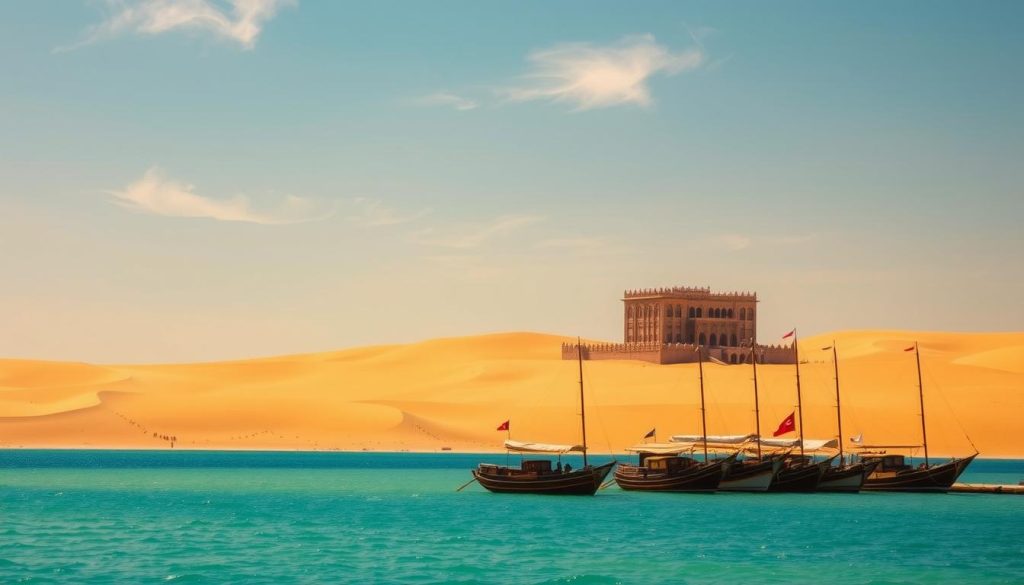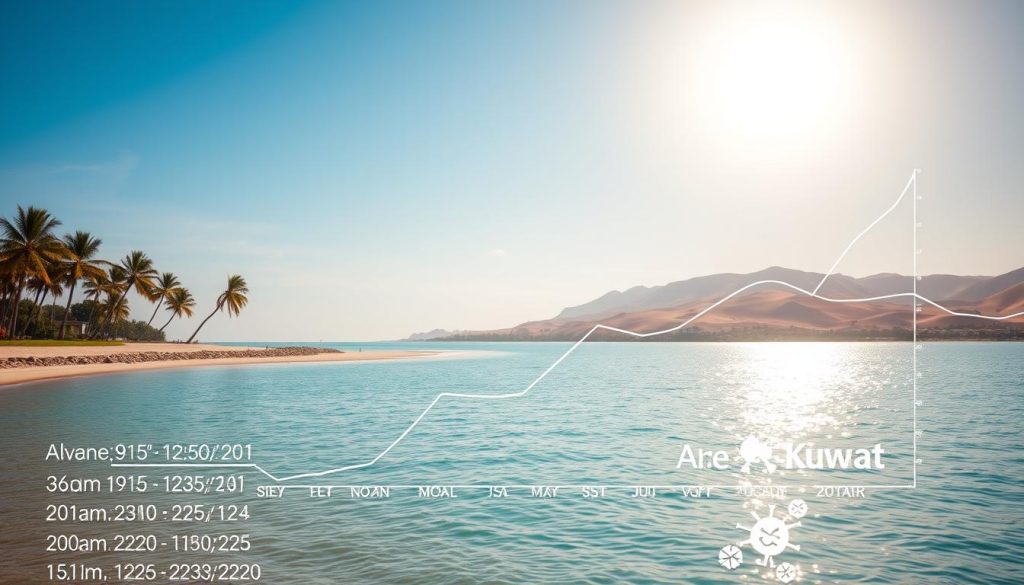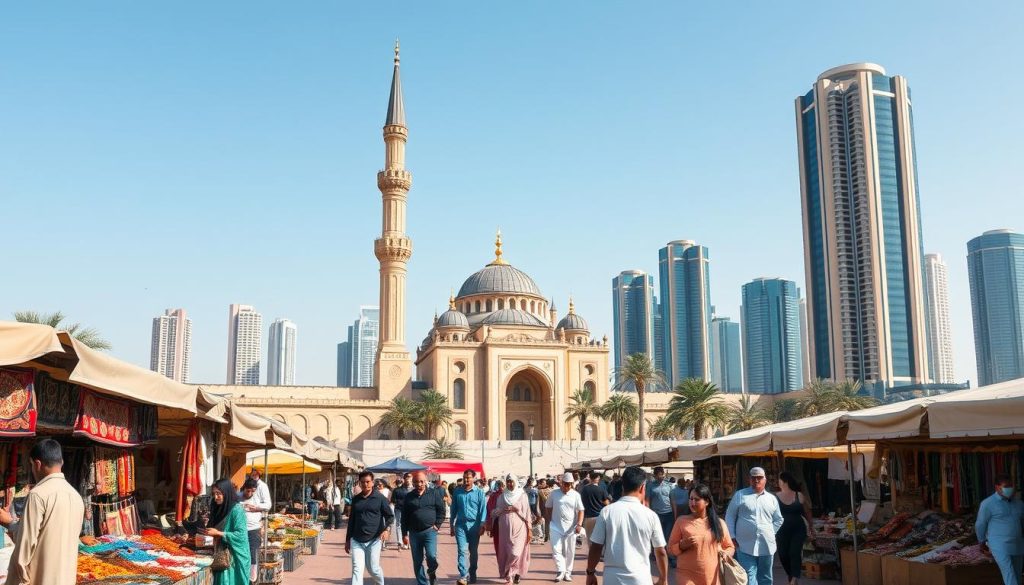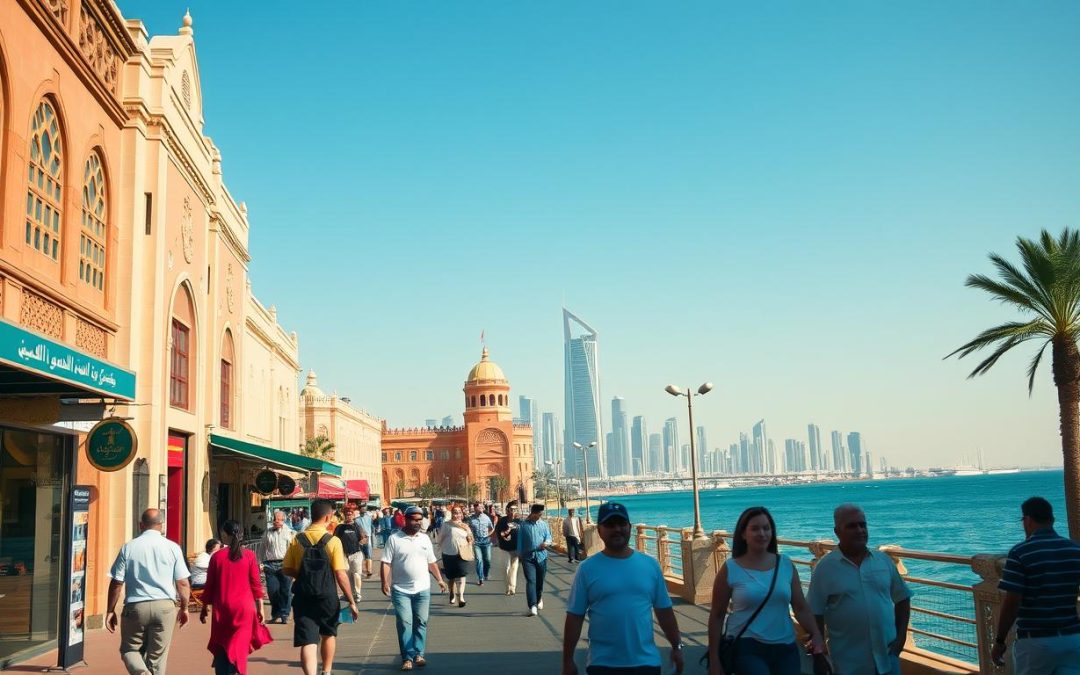Have you ever wondered when the perfect time is to explore a destination with extreme weather conditions? Planning a trip to a place like Kuwait requires careful consideration of its unique climate. With scorching summers and mild winters, timing your visit can make or break your experience.
Kuwait’s arid desert climate is known for its intense heat, with summer temperatures soaring above 46.9°C (117°F). On the other hand, winter brings cooler days, averaging around 19.5°C (67°F). This stark contrast makes it essential to choose the right month for your travel.
This guide will help you navigate the seasonal variations, temperature trends, and local events to ensure a memorable journey. Whether you’re avoiding the summer heat or embracing the mild winter, you’ll find tips to make the most of your time in this fascinating country.
Key Takeaways
- Kuwait’s desert climate features extreme summer heat and mild winters.
- Plan your visit during cooler months for a more comfortable experience.
- Winter temperatures average around 19.5°C (67°F), ideal for outdoor activities.
- Summer temperatures can exceed 46.9°C (117°F), making it less suitable for travel.
- Explore local attractions and cultural events by timing your trip wisely.
Understanding Kuwait’s Climate and Weather Patterns
Weather patterns play a crucial role in shaping your travel experience. In this region, the arid desert climate dominates, creating unique conditions that vary significantly throughout the year. Understanding these patterns will help you plan a more comfortable and enjoyable trip.

Overview of Kuwait’s Desert Climate
The desert climate here is characterized by extreme heat during the day and cooler nights. Summer temperatures often soar above 46.9°C (117°F), making outdoor activities challenging. In contrast, winter brings milder conditions, with average temperatures around 19.5°C (67°F).
This stark contrast between seasons means your travel plans should align with the weather. For example, visiting during the cooler months ensures a more pleasant experience, while summer travel requires careful preparation for the heat.
Seasonal Variations and Temperature Trends
Seasonal changes here are dramatic. Summers are intensely hot, with temperatures occasionally reaching record highs of 53.9°C (129°F). Winters, on the other hand, are mild and more suitable for exploring the city and its surroundings.
Even within a single season, temperatures can vary by month. For instance, March and November offer moderate weather, while February tends to be cooler. Knowing these trends helps you choose the best time to visit.
| Season | Average Temperature | Key Features |
|---|---|---|
| Summer | 46.9°C (117°F) | Extreme heat, dust storms |
| Winter | 19.5°C (67°F) | Mild weather, occasional rain |
| Spring | 25°C (77°F) | Moderate, ideal for travel |
Rain is rare but occurs occasionally in winter, adding a refreshing touch to the dry climate. Dust storms are more common during the hotter months, so it’s wise to stay informed about weather forecasts.
By understanding these patterns, you can choose the ideal month and time for your trip, ensuring a more comfortable and memorable experience.
Best Time to Visit: Kuwait: Best Months for a Weather-Savvy Trip
Choosing the right period to travel ensures a more enjoyable experience. In this region, the weather plays a significant role in shaping your journey. Understanding the ideal conditions and comparing peak and off-peak periods can help you plan a trip that’s both comfortable and memorable.

Identifying Ideal Weather Conditions
The best time to visit this destination is during the cooler months, from late October to April. During this period, temperatures are moderate, averaging around 19.5°C (67°F). This makes it perfect for outdoor activities and exploring the city.
Traveling during this season also allows you to enjoy local events and panoramic views without the discomfort of extreme heat. The cooler nights add to the overall experience, making it a great time to immerse yourself in the culture and attractions.
Comparing Peak and Off-Peak Periods
Peak travel months, from May to October, are marked by intense heat, with temperatures often exceeding 46.9°C (117°F). This can make outdoor exploration challenging and less enjoyable. Dust storms are also more common during this time, adding to the discomfort.
On the other hand, off-peak periods offer a quieter and more comfortable experience. The mild weather ensures you can explore at your own pace, while the lack of crowds allows for a more relaxed atmosphere. Here are some key advantages of traveling during the off-peak season:
- Moderate temperatures for outdoor activities.
- Cooler nights for a pleasant evening experience.
- Fewer crowds at popular attractions.
- Opportunities to enjoy local events without the summer heat.
By planning your visit during the ideal months, you can maximize your enjoyment and safety in a destination known for its extreme temperature variations.
Monthly Weather Breakdown and Temperature Trends
Understanding the monthly weather trends can help you plan a trip that suits your preferences. Each month brings unique conditions, from mild winters to scorching summers. Knowing what to expect ensures you’re prepared for the temperature shifts throughout the year.

Analyzing Winter and Spring Conditions
From December to March, the weather is mild and pleasant. Daytime temperatures average around 19.5°C (67°F), making it ideal for outdoor activities. Nights are cooler, offering a refreshing break from the daytime warmth.
Spring, from March to April, sees a gradual rise in heat. Daytime highs reach around 25°C (77°F), while nights remain comfortable. This season is perfect for exploring the city and enjoying local events without the summer’s intensity.
Extreme Summer Heat and Cooling Relief
From May to September, the summer heat becomes overwhelming. Daytime temperatures often exceed 46.9°C (117°F), with peaks reaching over 50°C (122°F). The intense heat makes outdoor activities challenging, and dust storms are common.
To cope, locals and visitors rely on air-conditioned spaces and stay hydrated. The sea temperature also rises, offering some relief for those who enjoy swimming. Planning indoor activities during this time is highly recommended.
By understanding these monthly trends, you can choose the ideal time to visit and make the most of your trip.
Navigating Seasonal Attractions and Events
Exploring a destination’s cultural calendar can transform your travel experience. In this region, seasonal attractions and events offer a unique lens into its vibrant culture. From religious festivals to public holidays, these occasions provide opportunities to immerse yourself in local traditions and celebrations.

Cultural Festivals and Public Holidays
Kuwait’s cultural calendar is rich with events that reflect its heritage. Ramadan, a significant religious observance, is marked by fasting and evening feasts. Eid al-Fitr, celebrated at the end of Ramadan, brings families together for joyous gatherings and traditional meals.
National Day, held in February, is another highlight. The city comes alive with parades, fireworks, and cultural performances. These events offer a glimpse into the nation’s pride and history, making them a must-see for any visitor.
Understanding School and National Breaks
School and national breaks play a key role in shaping tourism flow. During these periods, families often travel, creating a lively atmosphere in popular destinations. For example, the winter break in December and January coincides with milder weather, making it an ideal time to explore.
Here’s a breakdown of key breaks and their impact:
| Break Period | Duration | Tourism Impact |
|---|---|---|
| Winter Break | December – January | Increased family travel, festive events |
| Spring Break | March – April | Moderate crowds, cultural festivals |
| Summer Break | June – August | Fewer tourists, extreme heat |
Timing your visit around these breaks ensures you can enjoy the best of what the city has to offer. Whether it’s engaging in community festivities or savoring traditional hospitality, these periods provide a unique and enriching experience.
Travel Tips for a Comfortable Visit
Planning a trip to a destination with extreme weather requires smart preparation to ensure comfort and enjoyment. From packing the right gear to managing unexpected conditions, these tips will help you make the most of your visit.
What to Pack and Wear
Packing for this region means preparing for both scorching days and cooler nights. Light, breathable fabrics like cotton are ideal for daytime, while a light jacket or sweater is useful for evenings. Don’t forget a wide-brimmed hat, sunglasses, and sunscreen to protect against the intense sun.
For unexpected weather, include a compact umbrella and waterproof shoes. These items can be lifesavers during rare rain showers or dust storms. Packing smart ensures you’re ready for any condition.
Managing Heat, Dust Storms, and Rain
Extreme heat is a common challenge here. Stay hydrated by carrying a reusable water bottle and taking breaks in shaded or air-conditioned areas. If you encounter a dust storm, known locally as Shamal, cover your nose and mouth with a scarf or mask to avoid inhaling dust.
Rain is rare but can occur during winter months. When it does, roads may become slippery, so exercise caution. Planning your day around the weather forecast helps you stay safe and comfortable.
Booking Accommodation with Climate Control
Choosing the right place to stay is crucial for a comfortable trip. Look for hotels or rentals with reliable air conditioning to escape the daytime heat. Many accommodations also offer heating for cooler nights, ensuring a pleasant stay year-round.
Here’s a quick guide to selecting the right lodging:
| Feature | Why It Matters |
|---|---|
| Air Conditioning | Essential for cooling down during hot days. |
| Heating | Keeps you warm during cooler nights. |
| Insulated Windows | Reduces noise and dust during storms. |
By following these tips, you’ll be well-prepared to enjoy your trip, no matter the weather.
Local Experiences: Exploring Kuwait Beyond the Weather
Kuwait offers more than just weather insights; it’s a treasure trove of cultural and natural wonders waiting to be explored. From iconic landmarks to thrilling adventures, this destination promises unforgettable experiences for every type of traveler.
Discovering Iconic Landmarks in Kuwait City
Kuwait City is home to some of the most recognizable landmarks in the region. The Kuwait Towers, with their striking design, offer panoramic views of the city and the Arabian Gulf. Nearby, the Liberation Tower stands as a symbol of the country’s resilience and progress.
For history enthusiasts, the National Museum and the Tareq Rajab Museum provide a deep dive into the country’s rich heritage. These museums showcase artifacts, art, and exhibits that tell the story of Kuwait’s past and present.
Enjoying Coastal and Desert Adventures
Kuwait’s coastline is perfect for those who love the sea. Beautiful beaches, water sports, and boat trips to islands like Failaka offer a refreshing escape. The clear waters and serene surroundings make it an ideal spot for relaxation and adventure.
For a different kind of thrill, head to the desert. Experience the excitement of camel races or take an off-road exploration across the vast sand dunes. These activities provide a unique way to connect with the natural beauty of the region.
Timing your visit can enhance these experiences. Visiting during cooler months ensures you can enjoy outdoor activities comfortably, while summer trips might focus more on indoor attractions. Whether you’re exploring the city or venturing into the desert, Kuwait offers something for everyone.
Conclusion
Planning your trip around the right season can make all the difference in your experience. Understanding the temperature trends and weather patterns ensures you’re prepared for the conditions you’ll face.
Choosing the right month helps you avoid extreme heat and enjoy local attractions comfortably. Whether you’re exploring cultural events or natural wonders, timing is key to a memorable journey.
This guide provides actionable insights to help you plan confidently. Revisit the detailed sections for month-by-month information and practical tips. With the right preparation, your trip will be a perfectly timed adventure.
The above is subject to change.
Check back often to TRAVEL.COM for the latest travel tips and deals.
Here are some Tours & Sightseeing suggestions that might pique your interests!
